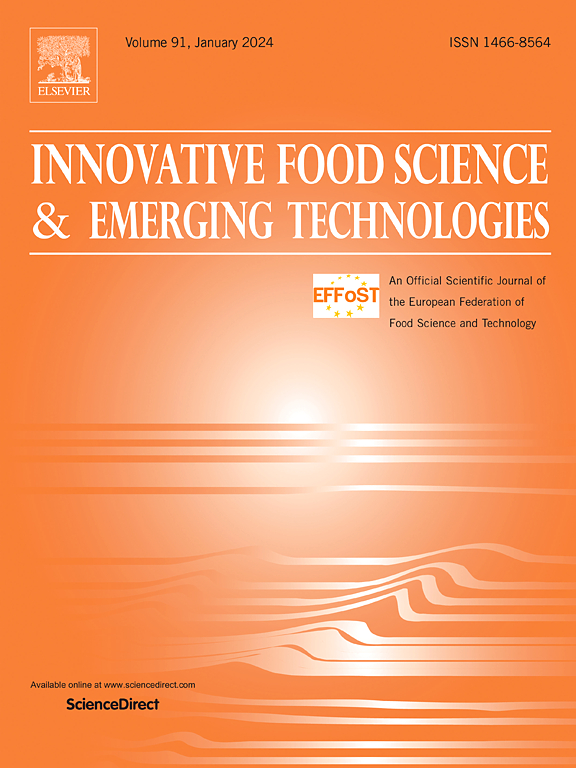静磁场辅助反复冻融对羊肉品质特征、微观结构和肌原纤维蛋白特性的影响
IF 6.3
1区 农林科学
Q1 FOOD SCIENCE & TECHNOLOGY
Innovative Food Science & Emerging Technologies
Pub Date : 2025-07-07
DOI:10.1016/j.ifset.2025.104112
引用次数: 0
摘要
本研究旨在评估静磁场辅助冷冻和解冻(SMF-FT)在提高羊肉品质、减少微观结构损伤和保持肌原纤维蛋白理化性质方面的有效性。研究结果表明,与常规冻融(RT-FT)相比,SMF-FT显著减少了解冻和离心损失,同时提高了保水能力。LF- NMR和MRI结果显示smf - ft处理的样品含水量较高。扫描电子显微镜(SEM)显示,SMF-FT处理使羊肉的肌纤维排列更紧密,减少了组织损伤。在SMF-FT处理下,蛋白质氧化变性和脂肪氧化得到缓解,这可以通过降低TBARS值、减少总巯基损失、降低羰基水平和表面疏水性来证明。FT-IR和内源荧光光谱分析表明,SMF-FT延缓了蛋白质二级和三级结构的变化。这些结果为在肉类冷冻和解冻过程中使用静态磁场提供了理论基础和技术指导,可能支持肉类工业的可持续发展。本文章由计算机程序翻译,如有差异,请以英文原文为准。
Effect of static magnetic field-assisted repeated freezing and thawing on quality characteristics, microstructure, and myofibrillar protein properties of lamb meat
This study aimed to evaluate the effectiveness of static magnetic field-assisted freezing and thawing (SMF-FT) in enhancing lamb meat quality, minimizing microstructural damage, and preserving the physicochemical properties of myofibrillar proteins. The findings indicated that SMF-FT significantly decreased thawing, and centrifugation loss while improving water retention compared to routine freeze-thawing (RT-FT). Results from LF- NMR and MRI revealed higher water content in SMF-FT-treated samples. Scanning electron microscopy (SEM) demonstrated that SMF-FT treatment resulted in more closely aligned muscle fibers and reduced tissue damage in lamb meat. Protein oxidative denaturation and fat oxidation were mitigated under SMF-FT treatment, as evidenced by lower TBARS values, reduced total sulfhydryl group loss, and lower levels of carbonyl groups and surface hydrophobicity. FT-IR and endogenous fluorescence spectroscopy analyses indicated that SMF-FT delayed the changes in the secondary and tertiary structures of the proteins. These results provide a theoretical foundation and technical guidance for using static magnetic fields in meat freezing and thawing processes, potentially supporting sustainable advancements in the meat industry.
求助全文
通过发布文献求助,成功后即可免费获取论文全文。
去求助
来源期刊
CiteScore
12.00
自引率
6.10%
发文量
259
审稿时长
25 days
期刊介绍:
Innovative Food Science and Emerging Technologies (IFSET) aims to provide the highest quality original contributions and few, mainly upon invitation, reviews on and highly innovative developments in food science and emerging food process technologies. The significance of the results either for the science community or for industrial R&D groups must be specified. Papers submitted must be of highest scientific quality and only those advancing current scientific knowledge and understanding or with technical relevance will be considered.

 求助内容:
求助内容: 应助结果提醒方式:
应助结果提醒方式:


